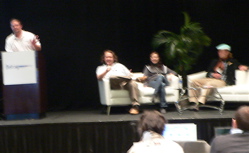A week after all the buzz about Open Social, this next session was bound to be a popular one. Then again, all that hype was getting way out of control, too, which prompted conference producer Eric Norlin to put forth what he thought was more significant news last week. Nonetheless, social networking is a part of our lives now, and this highly literate audience of tech and online community types was naturally all over this discussion of where social technology is headed. This panel would address some of the ways it’s playing out now inside the enterprise. [Excuse the crummy photo — I must have been shaking in anticipation.] 
Aaron Fulkerson of Mindtouch talked about his firm’s open source wiki and
application platform for communities and enterprises, which is seeing rapid adoption. (I blogged about this previously here.) He said wikis are easy-to-use tools for creating
web-based communities, improving employee
communication and collaboration. Tens of
thousands of organizations use MindTouch, Fulkerson said,including Microsoft, Fujitsu,
British Petroleum, and Stanford University. The company’s online community of users is at OpenGarden.org.
Dawn Foster, Director of Developer Relations for Jive Software, spoke about her company’s Clearspace social community software. She said her firm now uses it for their entire intranet, and that it’s all about "open collaboration." She said she gets virtually no email internally anymore — "it’s all collaborative IM."
The guy who stole the show, though [what is it with those British accents? …and weird hats], was Charles Armstrong, CEO of Trampoline Systems, all the way from the UK. He said his background is in anthropology, which led him to focus in "social computing." He’s studied how information gets distributed in small communities, and he said "we’ve been phenomenally successful in doing that." Trampoline builds analytic systems that mimic that activity. He described his system as kind of an "upside down social networking system." He said it integrates email, document management, and other information sources, to create "employee-facing tools to find expertise." Trampoline’s customers, he said, include a UK government agency, Raytheon, a TV network, and a global management consulting firm soon to be announced.
"Do we really need social networking in the enterprise?" asked moderator Eric Norlin. "Yes, because there are lots of data silos that are completely disconnected," said Mindtouch’s Fulkerson. Trampoline’s Armstrong said, "Studies show that work gets done in enterprises in informal networks, and social networking recognizes that and puts it to use." He noted we’re just at the beginning of all this, but that "brave companies are diving in." One relatively conservative customer company of his firm, he said, has had his system running for only three months, but already has 20,000 people using it.
"What about the younger demographic in all this — what affect does that have on the enterprise?" asked Norlin. Armstrong strongly feels that, to attract and retain younger workers, social networking technology is mandatory. Fulkerson added that, "What starts in IT in the way of wiki adoption is now rapidly spreading throughout the organization."
Another question: "How do you deal with the information overload problem?" Trampoline’s Armstrong: "We help you defend yourself against it." Mindtouch’s Fulkerson: "There’s no such thing as too much information, just not enough tools to filter it."
And a final sobering question: "Is there a possibility for individual employees to remove their info from a corporate social networking system?" Not under current law, said Armstrong. "We do have ways to split your corporate and personal data, however." Fulkerson said his firm also has such tools. "But what if I have an idea over lunch?" yelled Chris Locke from the audience. Armstrong: "If it’s put up on the wiki or email or social networking system at work, it’s company property."
UPDATE (11/6): For some great insight into social networking in the enterprise, see my colleague Alex Iskold’s post today on Read/Write Web, resulting from a conference last week back East. (Alex is also here at Defrag.)

Very interesting. Glad I stumbled accross this post, definitely going to bookmark this to refer back to it later. Thanks for the great read.
A public social network is by its very nature open and security is fairly loose. So instead organizations can look at inside the firewall social networks where privacy can be maintained while information freely flows throughout the business with reasonable assurance of security.